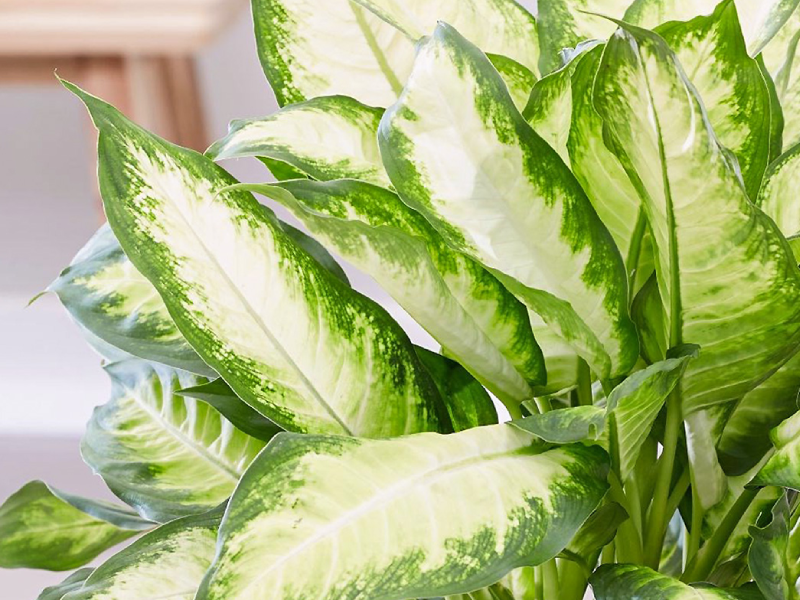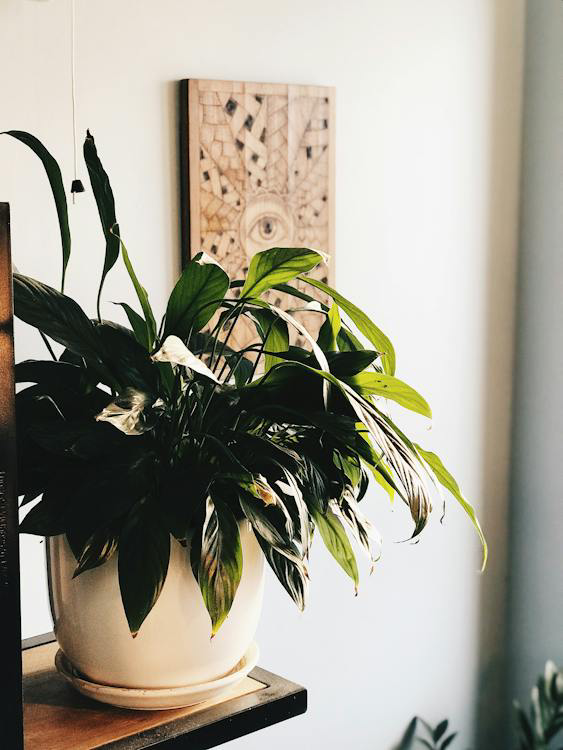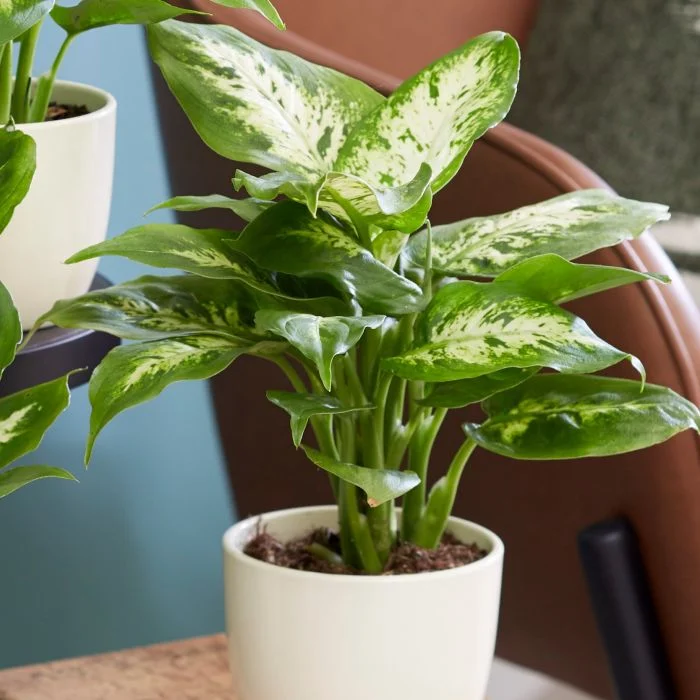Enter the exciting world of indoor house plants with the Leopard lily plant. It has beautiful spotted leaves that can add a touch of wild elegance to any home or office. The Leopard Lily, also called Dieffenbachia, is not only a stunning decoration but also offers benefits that make it a must-have for plant lovers and interior decorators.
Leopard houseplant propagation
Leopard lilies, prized for their striking foliage and vivid blooms, are garden darlings. If you’re keen to expand your collection or spread the joy, propagation is your way forward! Let’s explore three simple techniques to multiply your leopard lilies and reap horticultural rewards.

Stem Cuttings – An Elementary Starting Point
Stem cuttings are a breeze. Carefully select a vigorous stem with 4-5 leaves. Lop off the base tidily with clean clippers. Strip off all but two leaves, retaining some nodes. Dip the cut end in root hormone to spur root production. Keep the soil moist, and nestle the pot somewhere warm but not in the sun so roots can form. Soon, you’ll spy roots emerging from the cut end – success! Time to transplant into a larger pot or the garden proper.
Air Layering – Breathe New Life into Larger Lilies
Air layering excels at propagating substantial leopard lilies or reviving lagging plants. This enables you to coax roots while still attached to the parent plant. Choose a robust stem and nick it. Wrap the cut with moist sphagnum and seal with plastic wrap and tape to craft a humid microclimate for roots. Maintain moist moss! Inspect often and mist if drying. After some weeks, roots will materialize in the moss. Carefully sever the new rooted section and pot up a fresh plant!
Division – Ideal When Dormant
Dividing leopard lily clumps is also the most fruitful. Optimal when blooms have ceased. Gently extract the cluster to propagate, removing excess soil from the roots. Halve the mass into several portions with a sharp knife or shears, each with at least one viable root system. Prune the leaves to minimize strain. Replant divisions in new pots or gardens, selecting free-draining soil. Rinse thoroughly and situate in bright, indirect light. Shun temperature extremes.
Propagating leopard lilies is deeply fulfilling! Cuttings, division, and layering offer straightforward routes to expand your plot. With some TLC, your garden will soon overflow with thriving leopard lilies!
If you are interested in redecorating your home with elegant items, check out FMD Cabinets products.
leopard lily indoor plant care
Because of having dramatic spotted leaves, leopard houseplants are among best indoor plants and can bring striking elegance to indoor spaces. But these tropical beauties require some specific care and conditions to thrive indoors truly.

Leopard houseplants need bright, indirect light to flourish and is not a low light houseplants. Position them near an east or west-facing window where they’ll receive ample ambient daylight but no direct sunbeams on their foliage, which can scorch leaves. Low light will cause leggy, weak growth. Bright light keeps these plants lush and vibrant.
Maintaining proper temperatures: Since Dieffenbachia hails from tropical regions, Warm conditions between 65 and 80°F suit leopard houseplants best; avoid placing them near heating and cooling vents where temperature fluctuations can shock them. A spot in a warm, stable part of the room is ideal. Keep away from cold drafts as well.
Watering Appropriately: Let the top few inches of soil dry out between thorough watering. Control by putting your finger in the soil to gauge moisture. Overwatering leads to root rot, so dump out excess water in the drainage saucer after irrigating. Reduce watering frequency in winter when plants are dormant. Adding pebbles under the pot lifts it and increases humidity around the leaves.
Providing Nutrients: Use enough liquid fertilizer at half-strength monthly when plants are actively growing from spring through fall. Liquid fertilizers fuel the healthy growth of your plant. Take a break from fertilizing during the winter dormant period. An organic all-purpose fertilizer diluted properly also works well.
Repotting for continued growth: These fast-growing plants need repotting each spring before the new growth cycle starts. Shift them into a container one size larger with a fresh potting mix amended with compost for nutrients. Gently loosen any circled roots, but keep the root ball intact when repotting.
Pruning for shape: While leopard houseplants require minimal pruning, you can trim off dead leaves or trim back leggy stems to maintain an attractive shape. Always sterilize shears before cutting them to prevent disease transmission.
Proper sunlight exposure for Leopard Lily Succulents
Leopard Lily succulents require bright, indirect light to thrive. While they need ample light to sustain their growth, direct sunlight can scorch their leaves. Place them in a location with bright, filtered light, such as a south-facing window, or use sheer curtains to diffuse the sunlight.
If you’re growing Leopard Lilies outdoors, choose a spot with partial shade to shield them from intense afternoon sun. Morning sunlight is generally gentler and beneficial for their growth. Keep in mind that as the seasons change, the angle of the sun’s rays may vary, so make adjustments accordingly to ensure they receive the right amount of light.
What conditions do leopard lilies like to grow in?
Overwatering and low humidity often plague houseplant growers. Let the soil dry out between irrigations, and use a humidifier nearby. Spider mites can also become an issue. Wipe leaves down with neem oil or insecticidal soap sprays to prevent pests. Catch problems early before they spread.With the proper care, leopard houseplants can grow for years in indoor environments. Their incredible foliage makes a bold statement in any room when given bright filtered light, frequent humidity, occasional fertilizer, and attentive watering and repotting. Follow these tips for thriving leopard houseplants indoors.
Explore more about bathroom vanity san jose ca!
Leopard plant varieties
Known for their boldly speckled and splotched leaves, “leopard plants” encompass a range of houseplants with striking foliage reminiscent of a leopard’s spots. From Dieffenbachia to ligularia, these tropical beauties showcase an incredible diversity of leaf patterns and colors to match any indoor décor.

Classic Dieffenbachia
Dieffenbachia represents over 30 species of the well-known “dumb cane” plants in the aroid family. Originating in the rainforests of Central and South America, Dieffenbachia features oval leaves splashed in varying shades of green, white, yellow, and cream. Most are common houseplants, although their sap can irritate the skin. Popular Dieffenbachia varieties include:
- ‘Camille’ – Showcasing dark green leaves generously dotted with light green spots along the veins, this variety reaches 3 feet tall and tolerates low light.
- ‘Exotica’ – One of the most vivid, this type has dramatic, bright white splotches and speckles decorating its yellow-green leaves. It grows up to 6 feet tall.
- ‘Tropic Snow’ – A more compact variety under 2 feet tall, this Dieffenbachia has rich green leaves accented with creamy white spots and dots. It works well in terrariums.
- ‘Sara’ – Featuring spear-shaped leaves with bold white and pale green splotches on deep green, this variety adds height and drama to indoor spaces.
- Ornamental Farfugium Varieties
In the Asteraceae family, Farfugium japonicum originates from mountain streambanks in Japan and China. Also called ligularia or tractor seat plant, Farfugium has big, glossy, rounded leaves up to 18 inches wide and yellow daisy flowers. Popular ornamental Farfugium varieties include:
- Aureomaculatum: Bright yellow spots of varying sizes decorate the dark green rounded leaves of this Japanese native variety.
- Giganteum: As its name denotes, this farfugium boasts the largest leaves of any variety, up to 18 inches wide in solid dark green.
- Crispatum: Ruffled, crinkly leaf edges give this variety a fun green and cream variegated texture.
- Argenteum: This variety shows off dramatic contrast with leaves boldly splashed in dark green and silvery grey.
Vibrant tropical caladiums
Related to Dieffenbachia, caladiums are tuberous perennials cherished for their incredible diversity of leaf shapes, sizes, and color patterns. Most showcase white, pink, or red venation over green, white, purple, or silver backgrounds. Popular leopard-patterned caladiums include:
- White Splendor: Pure white leaves etched with green veins give this caladium bold contrast. It has spreading 18-inch foliage.
- Pink Splash: Bright pink midribs and veins decorate the medium green leaves of this low, mounding variety.
Why are the leaves on my leopard plant turning yellow?
With their bold, splashed, and spotted foliage, leopard houseplants add striking elegance to indoor spaces. However, these popular plants are also toxic, containing irritating sap. Care is required in placement and handling. Follow these tips to grow healthy leopard houseplants while keeping people and pets safe.
Choosing the right lighting conditions: Leopard houseplants thrive in medium to bright, indirect light. Near an east or west window provides ambient daylight without direct sun, which can burn leaves. Low light causes weak growth, yet bright filtered light keeps them lush. Rotate periodically for even exposure. Sheer curtains or artificial light work, too.

Providing Careful Watering: Let the top inch of soil dry out before thoroughly soaking the root zone. Always dump excess water from the drainage saucer. Too much moisture causes roots to rot. Reduce watering frequency in winter when dormant. Adding pebbles underneath can increase humidity.
Giving Warm Temperatures: These tropical-native plants prefer consistent temperatures of 65–80 °F. Avoid placement near heating and cooling vents where fluctuations happen. A stable, warm spot in the room is best. Cold drafts can also damage leaves.
Boosting Humidity: High humidity mimics the moist rainforest origins of leopard houseplants. Use a humidifier, place it on a pebble tray filled with water, or group plants together. Regular misting of leaves also prevents dry air problems like brown, crispy tips.
Feeding Occasionally: Use liquid fertilizer at half strength monthly during active growth periods from spring through fall. Take a break in the winter when it is dormant. Organic all-purpose options work, too, if diluted properly. Never overfeed, as it can burn leaves.
Repotting in Spring: These quick-growing plants need repotting each spring before the new growth cycle begins. Shift to a container one size larger using fresh potting mix amended with compost. Gently loosen circled roots when repotting, but don’t disturb the root ball.
Pruning for shape: Minimal pruning is required except for trimming off dead leaves, or leggy stems to maintain shape and fullness. Always sterilize shears before cutting to prevent the spreading of diseases. Monitor for pests like spider mites, too.
Common pests and diseases that affect Leopard Lily Succulents
Leopard Lilies are generally hardy plants, but they can still fall victim to common succulent pests and diseases. Keep an eye out for mealybugs, aphids, and spider mites, which can infest the leaves and stems. Regularly inspect your plants and take immediate action at the first sign of an infestation.
pest infestations: To treat pest infestations, you can remove them manually using a cotton swab dipped in rubbing alcohol. Alternatively, you can use organic insecticidal soap or neem oil to control the pests. Follow the instructions on the product label for safe and effective use.
Root rot: root rot is a common issue that occurs due to overwatering or poorly draining soil. To prevent root rot, ensure your Leopard Lilies are planted in well-draining soil and water them sparingly, allowing the soil to dry out between waterings. If you suspect root rot, gently remove the plant from its pot, trim away any rotting roots, and repot it in fresh, well-draining soil.
soft or mushy leaves: Soft or mushy leaves are a sign of rot. Check the roots for signs of decay and repot the plant in fresh, well-draining soil if necessary.
No new growth or lack of flowering: If your Leopard Lily isn’t producing new leaves or flowers, it may be due to insufficient light or incorrect temperature. Ensure they are receiving adequate light and adjust the temperature if necessary.
Is Leopard Lily toxic for pets?
Position leopard houseplants out of reach of pets and children since the sap can irritate the mouth and skin when ingested or chewed on. Wear gloves when handling these plants. Monitor for teeth marks or other signs of chewing.
With the right care, leopard houseplants can thrive for years indoors. However, vigilance is needed to keep kids and animals safe from the toxic sap. Follow these tips to grow healthy, vibrant specimens while taking proper precautions.
Freida Hemple: Chartreuse foliage with dark green splotches and dramatic burgundy veins makes a vivid statement in this 18–24-inch tall caladium.
With unlimited leaf patterns and colors, leopard plant varieties allow you to add striking drama to indoor garden spaces. Their diversity provides myriad options to match any unique décor.
KEYWORDS:
